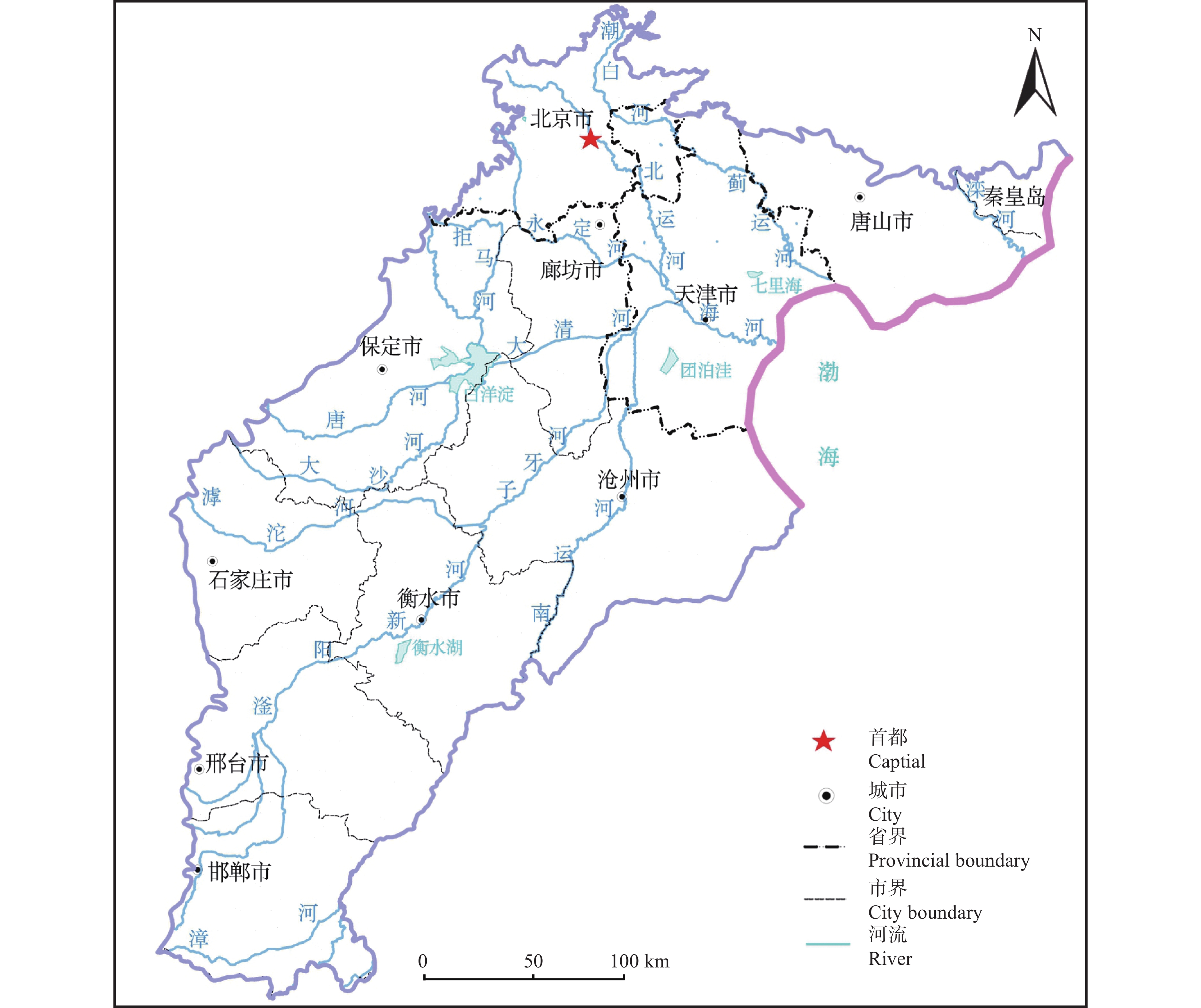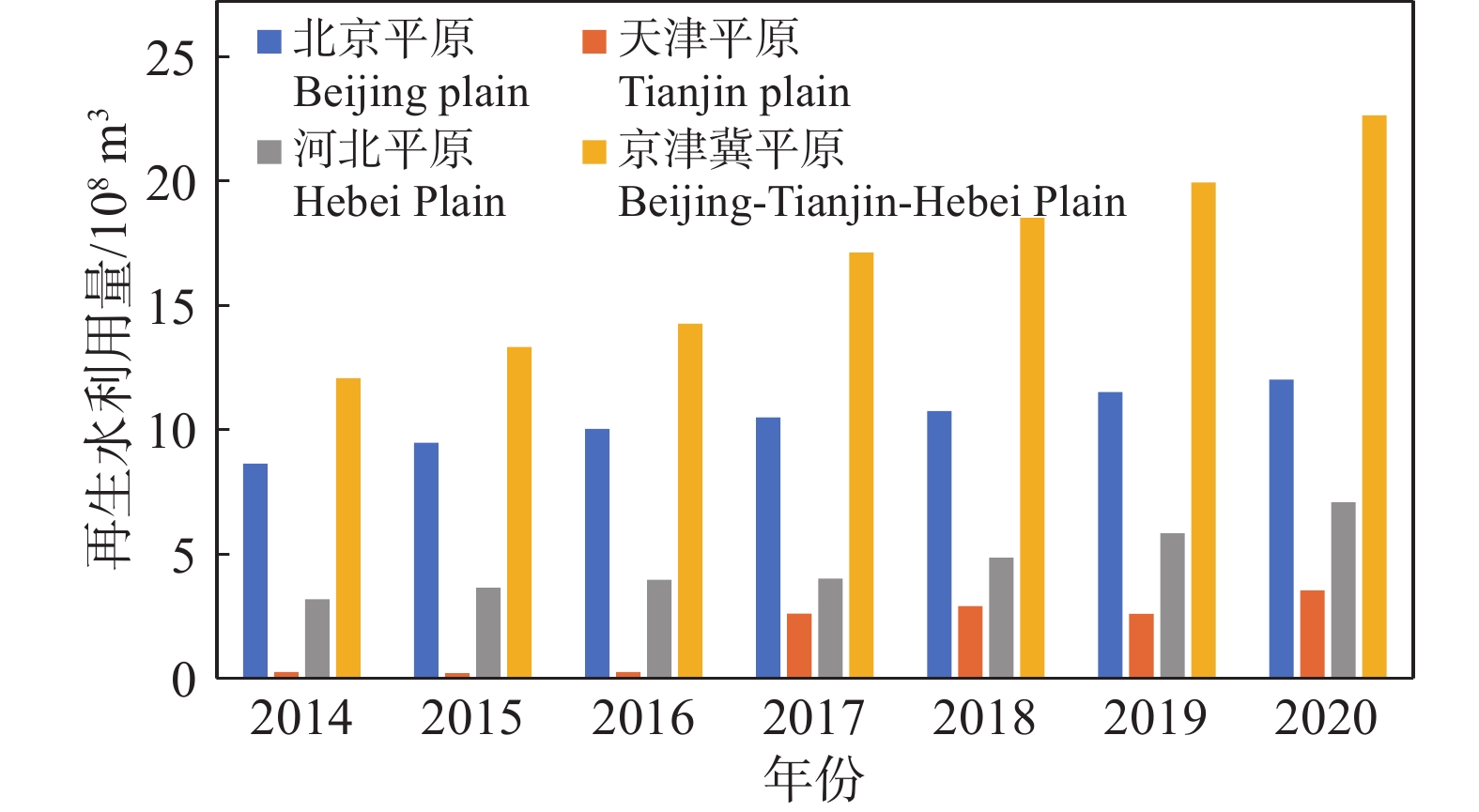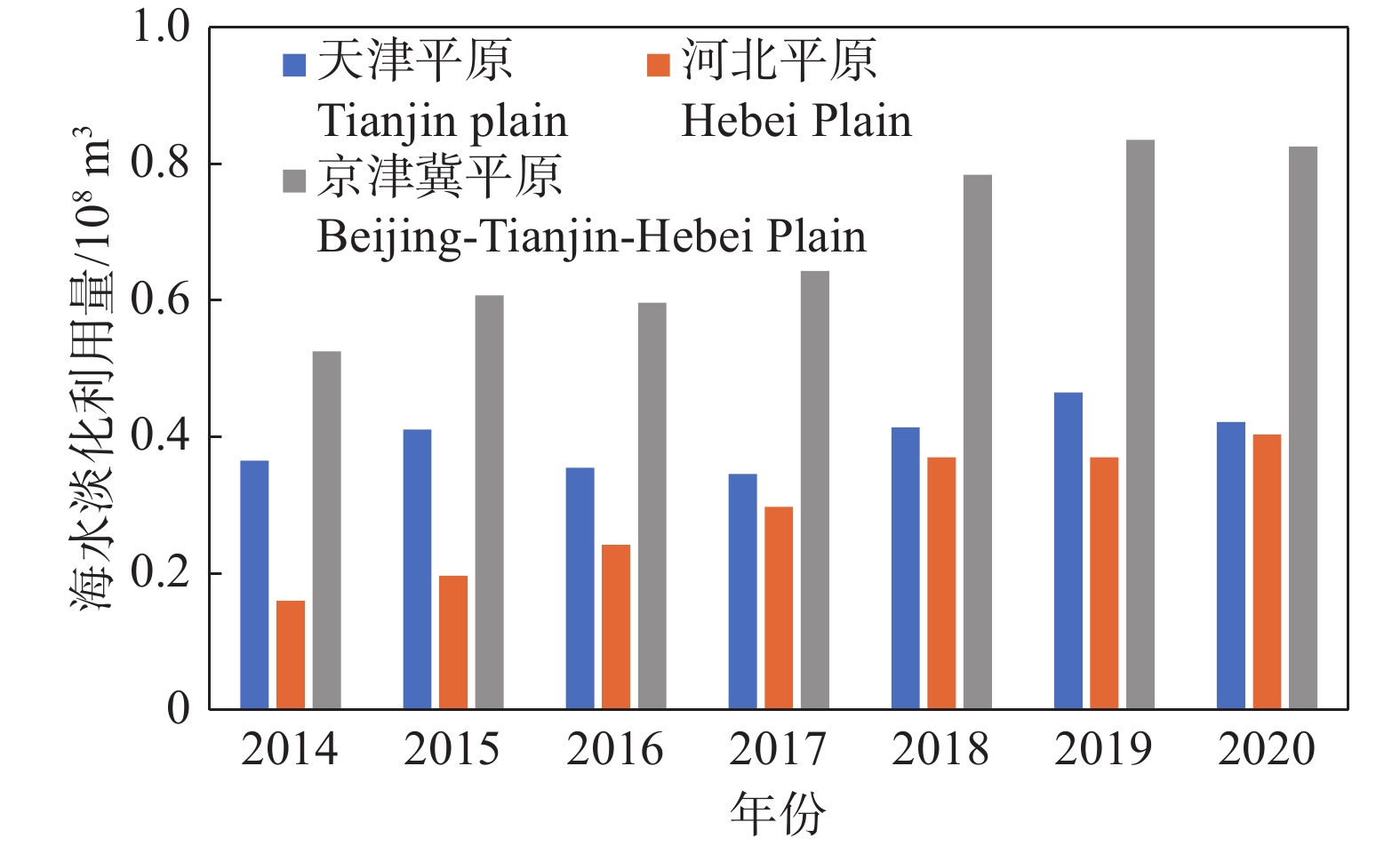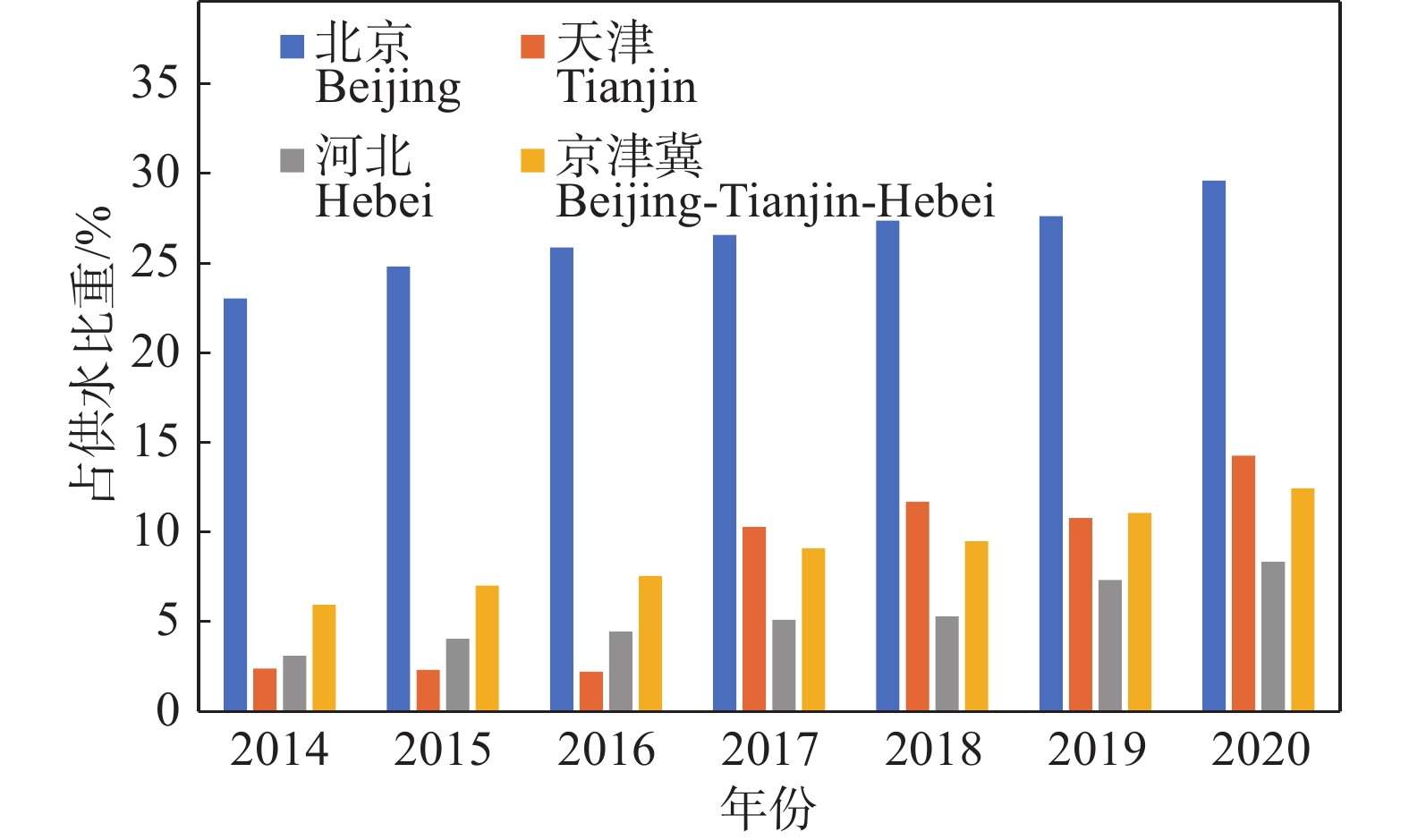Prospect analysis of unconventional water resources utilization and eco−environmental effects in Beijing−Tianjin−Hebei Plain
-
摘要:
研究目的 京津冀平原水资源严重短缺,供需矛盾十分突出,加大非常规水资源利用力度,形成多元供水格局,可有效缓解水资源供需矛盾,对支撑京津冀协同发展区社会经济协调发展和推动生态文明建设具有重要意义。
研究方法 文章系统开展非常规水资源供水方向、开发利用模式和供水规模分类数据统计,依据各省(直辖市)非常规水资源供水规划及配置目标,分析其开发利用前景及其生态环境效应。
研究结果 该区非常规水资源主要包括微咸水、再生水、淡化海水、雨洪水,其中微咸水主要分布于中东部平原的天津、沧州、衡水等地,供水前景为5.43×108 m3;再生水利用以北京、天津等大中型及工业城市为主,供水前景为34.22×108 m3;淡化海水利用以天津等滨海城市为主,供水前景为4.19×108 m3;雨洪水利用较分散。
结论 (1)微咸水用于农业灌溉存在土壤盐渍化风险,需加强水盐调控。(2)再生水用于河流生态补水,沿线地表水富营养化,地下水体未受到明显污染;地下水浅埋区开展再生水灌溉,会增加硝酸盐污染风险;建议将高风险的新兴污染物纳入再生水利用监控体系。(3)海水淡化尾液浓盐水、冷却热水可能改变天然海洋生态系统的分布、构成与多样性,应予以关注。(4)雨洪水利用可降低污水入河的水质风险,但过度利用可能影响区域生态系统的稳定性,建议城市区适度扩大利用。
Abstract:This paper is the result of hydrogeological survey engineering.
Objective The Beijing−Tianjin−Hebei Plain faces a serious shortage of water resources, and the contradiction between supply and demand is very prominent. Increasing the use of unconventional water resources and forming a diversified water supply pattern is of great significance to effectively alleviate the contradiction between supply and demand and support the socio−economic development and ecological civilization construction of the Beijing Tianjin Hebei Urban Agglomeration.
Methods This paper systematically carries out classified data statistics on supply directions, development and utilization models, and water supply scaleof unconventional water resources. We analyze their development and utilization prospects and ecological environment effects according to the planning and allocation objectives of unconventional water resources in Beijing−Tianjin−Hebei Plain.
Results Unconventional water resources in the area include brackish water, recycled water, desalinated seawater, rain water. The brackish water is mainly distributed in Tianjin, Cangzhou, Hengshui in the central and eastern plains, with a water supply prospect of 5.43×108 m3; Recycled water is mainly used in large industrial cities such as Beijing and Tianjin, with a water supply prospect of 34.22 ×108 m3; Desalinated seawater is mainly used in Tianjin and other coastal cities, with a water supply prospect of 4.19 ×108 m3; The use of rainwater is relatively scattered.
Conclusions (1) There is a risk of soil salinization when brackish water is used for agricultural irrigation, and water and salt regulation should be strengthened. (2) The recycled water is used for ecological replenishment of rivers, the surface water is eutrophic and the groundwater is not obviously polluted; Irrigation with recycled water in shallow groundwater buried areas will increase the risk of nitrate pollution; It is suggested that high-risk emerging pollutants be included in the monitoring system of recycled water use. (3) The concentrated brine and cooling hot water from the tail liquor of seawater desalination may change the distribution, composition and diversity of natural marine ecosystems, which should be paid attention to. (4) The use of rainwater can reduce the water quality risk of sewage entering the river, but excessive use may affect the stability of the regional ecosystem. It is recommended that urban areas appropriately expand the use.
-

-
图 2 京津冀平原水文地质剖面图(据张兆吉等,2009)
Figure 2.
表 1 京津冀平原微咸水、半咸水可开采资源量( 108 m3/a )
Table 1. Exploitable resources of brackish water in Beijing−Tianjin−Hebei Plain (108 m3/a)
行政区 微咸水
(2~3g/L)半咸水
(3~5g/L)合计 天津平原 0.75 1.41 2.16 河北平原 石家庄 0.20 / 0.20 唐山 0.85 0.62 1.47 秦皇岛 0.14 0.01 0.15 邯郸 0.48 / 0.48 邢台 1.07 0.7 1.77 沧州 1.18 1.27 2.45 廊坊 0.06 0.01 0.07 衡水 1.55 0.56 2.11 合计 5.53 3.17 8.70 京津冀平原 6.28 4.58 10.86 表 2 京津冀非常规水资源供水状况(108 m3)
Table 2. Supply of unconventional water resources in Beijing, Tianjin and Hebei (108 m3)
行政区 非常规水资源 2014年 2015年 2016年 2017年 2018年 2019年 2020年 北京市 再生水 8.64 9.48 10.04 10.50 10.76 11.52 12.02 天津市 再生水 0.26 0.21 0.26 2.61 2.91 2.60 3.55 海水淡化 0.37 0.41 0.35 0.35 0.41 0.47 0.42 天津小计 0.63 0.62 0.61 2.96 3.32 3.07 3.97 河北省 再生水 3.18 3.64 3.97 4.02 4.86 5.84 7.09 海水淡化 0.16 0.20 0.24 0.30 0.37 0.37 0.40 微咸水 0.96 1.19 1.01 0.97 1.04 0.78 0.55 河北小计 4.30 5.03 5.22 5.29 6.27 6.99 8.04 京津冀 再生水 12.08 13.33 14.27 17.13 18.53 19.96 22.65 海水淡化 0.53 0.61 0.60 0.64 0.78 0.84 0.82 微咸水 0.96 1.19 1.01 0.97 1.04 0.78 0.55 京津冀小计 13.57 15.13 15.87 18.74 20.35 21.57 24.03 -
[1] Beithou N. 2015. Non–conventional water resources: Review and developments[J]. International Journal of Research in Sciences, 3(1): 1−8.
[2] Cai Dawei, Kong Shuqiong, Liu Ruiqi. 2020. A review of brackish water for agricultural safe irrigation[J]. Water Saving Irrigation, (10): 91−95, 100 (in Chinese with English abstract).
[3] Chen Jian, Liu Weijiang, Bai Fugao, Zhang Man. 2016. Suggestions for risk management of groundwater recharge with reclaimed water[J]. Environmental Protection Science, 42(5): 22−25 (in Chinese with English abstract).
[4] Chen Weiping. 2011. Reclaimed water reuse experience in California and hints to China[J]. Chinese Journal of Environmental Engineering, 5(5): 961−966 (in Chinese with English abstract).
[5] Chen Weiping, Lü Sidan, Wang Meie, Jiao Wentao. 2013. Effects of reclaimed water recharge on groundwater quality: A rewiew[J]. Chinese Journal of Applied Ecology, 24(5): 1253−1262 (in Chinese with English abstract).
[6] Cui Bingjian, Gao Feng, Hu Chao, Li Zhongyang, Fan Xiangyang, Cui Erping. 2019. The use of brackish and reclaimed waste water in agriculture: A review[J]. Journal of Irrigation and Drainage, 38(07): 60−68 (in Chinese with English abstract).
[7] Fang Sheng, Chen Xiuling. 2005. Influence of atmospheric precipitation on soil leaching and desalinization in the north China plain[J]. Acta Pedologica Sinica, (5): 28−34 (in Chinese with English abstract).
[8] Feng Kai. 2012. Upgrading and reconstruction process design for the Gaobeidian reclaimed water treatment plant in Beijing City[J]. Water & Wastewater Engineering, 48(12): 35−39 (in Chinese with English abstract).
[9] Feng Ping, Liu Wei, Luo Sha. 2006. Utilization of rainwater resources and its experiment[J]. Journal of Tianjin University(Science and Technology), (3): 269−272 (in Chinese with English abstract).
[10] Gao Chuanchang, Liu Xing. 2007. Research progress on the application of urban unconventional water resources[J]. Journal of Irrigation and Drainage, 26(S1): 68−70 (in Chinese).
[11] Geng Zhi, Wu Zhongqiang, Wang Xiaojun, Wang Yuening. 2016. Case analysis of water quality variationin the shallow groundwater recharging with reclaimed water[J]. Journal of China Institute of Water Resources and Hydropower Research, 14(4): 304−310 (in Chinese with English abstract).
[12] Hamdy A. 2002. Sustainable use and management of non–conventional water resources in the arid regions[J]. Acta Horticulturae, 573: 159−174.
[13] He Jiangtao, Shen Zhaoli. 2010. Trends of reclaimed water infiltration recharge[J]. Chinese Journal of Nature, 32(6): 348−352 (in Chinese with English abstract).
[14] Hussain M I, Muscolo A, Farooq M, Ahmael W. 2019. Sustainable use and management of non–conventional water resources for rehabilitation of marginal lands in arid and semiarid environments[J]. Agricultural Water Management, 221: 462−476 doi: 10.1016/j.agwat.2019.04.014
[15] Jiang Ruixue, Han Dongmei, Song Xianfang, Yang Lihu, Li Binghua. 2020. Impacts of reclaimed water recharge to a riverchannel on ambient water bodies: A case study of the Chaobai River in Beijing[J]. Resources Science, 42(12): 2419−2433 (in Chinese with English abstract).
[16] Kelly S F, Sara D, Tracy S. 2019. Public acceptance of recycled water[J]. International Journal of Water Resource Development, 35(4): 551−586. doi: 10.1080/07900627.2017.1419125
[17] Li Guozheng, Su Xiaohong, Jian Mingkai. 2005. Current situation, potential analysis and countermeasures of non–ordinary water resources in Hebei Province[J]. Water Resources Protection, (3): 58−60 (in Chinese with English abstract).
[18] Li Lei, Liu Shujing. 2015. Development potential and patterns of sea water desalination in Binhai New Area of Tianjin[J]. Journal of Economics of Water Resources, 33(1): 48−50, 75 (in Chinese with English abstract).
[19] Li Ping, Qi Xuebin, Kang Lianqiang, Fan Xiangyang, Fan Tao, Zhao Zhijuan, Qiao Dongmei. 2008. Soil nitrogen transport and transformation of reclaimed water irrigated summer–maize under different groundwater levels[J]. Chinese Journal of Eco–Agriculture, (6): 1384−1388 (in Chinese with English abstract).
[20] Liu Chunyan, Huang Guanxing, Jing Jihong, Liu Jingtao, Zhang Ying, Guo Weixuan. 2023. Characteristics and driving mechanisms of evolution of groundwater chemistry in Huang–Huai–Hai Plain and suggestions for its exploitation and utilization[J]. Geology in China, 50(6): 1705−1719(in Chinese with English abstract).
[21] Lian L, Michael R, Bryan E. 2018. An impact assessment for urban stormwater use[J]. Environmental Science and Pollution Research, 25: 19259−19270. doi: 10.1007/s11356-017-0547-4
[22] Liu Jie, Guo Jingjing, Ma Yunxia. 2011. Analysis on utilization status of unconventional water resources in Tianjin[J]. Haihe Water Resources, (1): 11−14 (in Chinese).
[23] Liu Jing, Gao Zhanyi. 2012. Advances in study and practice of brackish water irrigation in China[J]. Water Resources and Hydropower Engineering, 43(1): 101−104 (in Chinese with English abstract).
[24] Liu Shujing, Wang Jing, Xing Shuying, Li Lei. 2018. Suggestions on further promoting seawater desalination water into water resource allocation system[J]. Science and Technology Management Research, 38(17): 233−236 (in Chinese with English abstract).
[25] Liu Tianxu. 2015. Development and utilization of unconventional water sources in Hebei Province[J]. Water Science and Engineering Technology, (4): 28−31.
[26] Long Qiubo, Yuan Gang, Wang Lizhi, Wu Junjian. 2010. Study on present situation and exploitation and utilization of brackish water in Guantao County of Hebei Province[J]. Journal of Water Resources and Water Engineering, 21(4): 126−129 (in Chinese with English abstract).
[27] Ma Tao, Liu Jiufu, Peng Anbang, Zheng Jintao, Wang Wenzhong, Zheng Hao, Deng Xiyuan. 2020. Progress in development and utilization of non–conventionalwater resources in China[J]. Advances in Water Science, 31(6): 960−969 (in Chinese with English abstract).
[28] Ma Tao, Liu Jiufu, Deng Xiyuan. 2020. The development course and suggestions of wastewater reuse in China[J]. China Water Resources, (7): 32−34,37 (in Chinese with English abstract).
[29] Ma Xuehu, Lan Zhong, Wang Sifang, Li Lu. 2011. Impact of discharges in seawater desalination on marine environment and progress of zero liquid discharge[J]. Chemical Industry and Engineering Progress, 30(1): 233−242 (in Chinese with English abstract).
[30] Ma Zhongsheng, Tan Junli, Wei Tong. 2019. The variation of salt–tolerance of crops in different regions irrigated with brackish water in China[J]. Journal of Irrigation and Drainage, 38(3): 70−75 (in Chinese with English abstract).
[31] Mu Ying, Wang Lijin. 2020. Application status and utilization prospect of several unconventional water resources[J]. Science & Technology Vision, (11): 222−224 (in Chinese with English abstract).
[32] Ni Xinye, Hao Tian, Wang Zhenzhen, Wei Jincheng. 2022. Research on standard and specification system of unconventional water resources utilization in China[J]. China Water & Wastewater, 38(14): 52−59 (in Chinese with English abstract).
[33] Qadir M, Sharma B R, Bruggeman A, Choukr–Allah R, Karajeh F. 2007. Non–conventional water resources and opportunities for water augmentation to achieve food security in water scarce countries[J]. Agricultural Water Management, 87: 2−22 doi: 10.1016/j.agwat.2006.03.018
[34] Ren Rong, Wang Zongjie. 1991. Analysis on utilization of brackish water in Nanpi salt reform test area[J]. Geotechnical Investigation & Surveying, (2): 38−43 (in Chinese with English abstract).
[35] Salgot M, Tapias J C. 2004. Non–conventional water resources in coastal areas: a review on the use of reclaimed water[J]. Geologica Acta, 2(2): 121−133.
[36] Stephen N N, Hubert H G S, Josephine N T, Johan R, Penning D V F W T. 2004. Agro–hydrological evaluation of on–farm rainwater storage systems for supplemental irrigation in Laikipia district, Kenya[J]. Agricultural Water Management, 73: 21−41.
[37] Su Ying, Wang Quanjiu, Ye Haiyan, Shi Xiaonan. 2005. Research of soil water and salt trasport feature for alternative irrigation of fresh and saline water[J]. Journal of Irrigation and Drainage, (1): 50−53 (in Chinese with English abstract).
[38] Wang Hui. 2016. Advances in study of brackish water irrigation in China[J]. Water Saving Irrigation, (6): 59−63 (in Chinese with English abstract).
[39] Wu X Q, Dodgen K L, Conkle L J, Gan J. 2015. Plant uptake of pharmaceutical and personal care products from recycled water and biosolids: A review[J]. Science of The Total Environment, 536: 655−666. doi: 10.1016/j.scitotenv.2015.07.129
[40] Yang Haojie, Song Zelin, LiuTiantian, Li Yan. 2021. Development status and application analysis of seawater desalination industry in Hebei Province[J]. Journal of Hebei University of Water Resources and Electric Engineeging, 31(4): 44−49 (in Chinese with English abstract).
[41] Yang Huifeng, Cao Wengeng, Zhi Chuanshun, Li Zeyan, Bao Xilin, Ren Yu, Liu Futian, Fan Cunliang, Wang Shufang, Wang Yabin. 2021a. Evolution of groundwater level in the North China Plain in the past 40 years and suggestions on its overexploitation treatment[J]. Geology in China, 48(4): 1142−1155 (in Chinese with English abstract).
[42] Yang Huifeng, Meng Ruifang, Li Wenpeng, Li Zeyan, Zhi Chuanshun, Bao Xilin, Li Changqing, Liu Futian, Wu Haiping, Ren Yu. 2021b. Groundwater resources of the Haihe River Basin and its development potential[J]. Geology in China, 48(4): 1032−1051 (in Chinese with English abstract).
[43] Yao Sumei, Wu Dafu. 2008. Some studies on unconventional water resources utilization in agriculture[J]. Journal of Water Resources and Water Engineering, (4): 24−27, 32 (in Chinese with English abstract).
[44] Zhang Jinshun. 2008. Prospect of open source water resources in Haihe River Basin from seawater desalination in Tianjin[J]. Haihe Water Resources, (2): 21−23 (in Chinese).
[45] Zhang Junjie. 2011. Discussion on comprehensive development and utilization of brackish water and brackish water[J]. Ground Water, 33(1): 44−45 (in Chinese).
[46] Zhang Yazhe, Shen Jianmei, Wang Ying, Wang Jianzhong. 2009. Distribution characteristics and development and utilization of underground (slightly) saline water in Hebei Plain[J]. Journal of Agricultural Resources and Environment, 26(6): 29−33 (in Chinese).
[47] Zhang Yue. 2013. Speeding up the development and utilization of unconventional water resources[J]. Water Resources Development Research, 13(1): 13−16, 68 (in Chinese).
[48] Zhang Zhaoji, Fei Yuhong, Chen Zongyu. 2009. Investigation and Evaluation of Groundwater Sustainable Utilization in North China Plain[M]. Beijing : Geological Publishing House (in Chinese).
[49] Zhu Jinjin, Sun Junna, Zhang Zhenhua, Yang Runya, Pan Yinghua, Yang Mao. 2019. Effects of alternate irrigation with brackish and fresh water on water and salt movement in coastal saline soil[J]. Research of Soil and Water Conservation, 26(5): 113−117, 122 (in Chinese with English abstract).
[50] 蔡达伟, 孔淑琼, 刘瑞琪. 2020. 微咸水农田安全灌溉研究进展[J]. 节水灌溉, (10): 91−95, 100. doi: 10.3969/j.issn.1007-4929.2020.10.019
[51] 陈坚, 刘伟江, 白福高, 张嫚. 2016. 再生水回灌地下水风险管理建议[J]. 环境保护科学, 42(5): 22−25.
[52] 陈卫平. 2011. 美国加州再生水利用经验剖析及对我国的启示[J]. 环境工程学报, 5(5): 961−966
[53] 陈卫平, 吕斯丹, 王美娥, 焦文涛. 2013. 再生水回灌对地下水水质影响研究进展[J]. 应用生态学报, 24(5): 1253−1262.
[54] 崔丙健, 高峰, 胡超, 李中阳, 樊向阳, 崔二苹. 2019. 非常规水资源农业利用现状及研究进展[J]. 灌溉排水学报, 38(7): 60−68.
[55] 方生, 陈秀玲. 2005. 华北平原大气降水对土壤淋洗脱盐的影响[J]. 土壤学报, (5): 28−34.
[56] 冯凯. 2012. 北京高碑店再生水处理厂升级改造工艺方案设计[J]. 给水排水, 48(12): 35−39.
[57] 冯平, 刘伟, 罗莎. 2006. 雨水资源的利用及其实验[J]. 天津大学学报, (3): 269−272. doi: 10.3969/j.issn.0493-2137.2006.03.003
[58] 高传昌, 刘兴. 2007. 城市非常规水资源的应用研究进展[J]. 灌溉排水学报, 26(S1): 68−70.
[59] 耿直, 武中强, 王小军, 王玥宁. 2016. 再生水回灌浅层地下水水质变化实例分析[J]. 中国水利水电科学研究院学报, 14(4): 304−310.
[60] 何江涛, 沈照理. 2010. 再生水入渗回灌利用的发展趋势[J]. 自然杂志, 32(6): 348−352.
[61] 姜瑞雪, 韩冬梅, 宋献方, 杨丽虎, 李炳华. 2020. 再生水补给河道周边水体特征——以北京潮白河顺义段为例[J]. 资源科学, 42(12): 2419−2433.
[62] 李国正, 苏晓虹, 简明凯. 2005. 河北省“非常规水资源”现状、潜力分析及对策[J]. 水资源保护, (3): 58−60.
[63] 李磊, 刘淑静. 2015. 天津滨海新区海水淡化发展潜力与模式分析[J]. 水利经济, 33(1): 48−50,75.
[64] 李平, 齐学斌, 亢连强, 樊向阳, 樊涛, 赵志娟, 乔冬梅. 2008. 不同潜水埋深再生水灌溉夏玉米土壤氮素运移研究[J]. 中国生态农业学报, (6): 1384−1388.
[65] 刘春燕, 黄冠星, 荆继红, 刘景涛, 张英, 郭维轩. 2023. 黄淮海平原地下水化学演化特征、形成机制及其开发利用建议[J]. 中国地质50(6): 1705−1719.
[66] 刘杰, 郭晶晶, 马云霞. 2011. 天津市非常规水资源利用现状分析[J]. 海河水利, (1): 11−14.
[67] 刘静, 高占义. 2012. 中国利用微咸水灌溉研究与实践进展[J]. 水利水电技术, 43(1): 101−104.
[68] 刘淑静, 王静, 邢淑颖, 李磊. 2018. 海水淡化纳入水资源配置现状及发展建议[J]. 科技管理研究, 38(17): 233−236. doi: 10.3969/j.issn.1000-7695.2018.17.034
[69] 刘天旭. 2015. 河北省非常规水源开发利用[J]. 水科学与工程技术, (4): 28−31.
[70] 龙秋波, 袁刚, 王立志, 武军剑. 2010. 邯郸市东部平原区微咸水现状及开发利用研究[J]. 水资源与水工程学报, 21(4): 126−129.
[71] 马涛, 刘九夫, 彭安帮, 郑锦涛, 王文种, 郑皓, 邓晰元. 2020b. 中国非常规水资源开发利用进展[J]. 水科学进展, 31(6): 960−969.
[72] 马涛, 刘九夫, 邓晰元. 2020a. 我国污水资源化利用的发展历程与推进建议[J]. 中国水利, (7): 32−34, 37.
[73] 马学虎, 兰忠, 王四芳, 李璐. 2011. 海水淡化浓盐水排放对环境的影响与零排放技术研究进展[J]. 化工进展, 30(1): 233−242.
[74] 马中昇, 谭军利, 魏童. 2019. 中国微咸水利用的地区和作物适应性研究进展[J]. 灌溉排水学报, 38(3): 70−75.
[75] 穆莹, 王金丽. 2020. 几种非常规水资源应用现状及利用前景[J]. 科技视界, (11): 222−224.
[76] 倪欣业, 郝天, 王真臻, 魏锦程. 2022. 我国非常规水资源利用标准规范体系研究[J]. 中国给水排水, 38(14): 52−59.
[77] 任荣, 王宗杰. 1991. 以南皮盐改试区为例浅析咸水的利用[J]. 工程勘察, (2): 38−43.
[78] 苏莹, 王全九, 叶海燕, 史晓楠. 2005. 咸淡轮灌土壤水盐运移特征研究[J]. 灌溉排水学报, (1): 50−53.
[79] 王辉. 2016. 我国微咸水灌溉研究进展[J]. 节水灌溉, (6): 59−63.
[80] 杨豪杰, 宋泽霖, 刘甜甜, 李岩. 2021. 河北省海水淡化产业发展现状及应用分析[J]. 河北水利电力学院学报, 31(4): 44−49.
[81] 杨会峰, 曹文庚, 支传顺, 李泽岩, 包锡麟, 任宇, 柳富田, 范存良, 王树芳, 王亚斌. 2021a. 近40年来华北平原地下水位演变研究及其超采治理建议[J]. 中国地质, 48(4): 1142−1155.
[82] 杨会峰, 孟瑞芳, 李文鹏, 李泽岩, 支传顺, 包锡麟, 李长青, 柳富田, 吴海平, 任宇. 2021b. 海河流域地下水资源特征和开发利用潜力[J]. 中国地质, 48(4): 1032−1051.
[83] 姚素梅, 吴大付. 2008. 非常规水资源农业利用的若干问题研究[J]. 水资源与水工程学报, (4): 24−27, 32.
[84] 张金顺. 2008. 从天津市海水淡化看海河流域水资源开源的前景[J]. 海河水利, (2): 21−23.
[85] 张俊杰. 2011. 微咸水、咸水综合开发利用探讨[J]. 地下水, 33(1): 44−45.
[86] 张亚哲, 申建梅, 王莹, 王建中. 2009. 河北平原地下(微)咸水的分布特征及开发利用[J]. 农业环境与发展, 26(6): 29−33.
[87] 张岳. 2013. 加快非常规水资源的开发利用[J]. 水利发展研究, 13(1): 13−16, 68. doi: 10.3969/j.issn.1671-1408.2013.01.003
[88] 张兆吉, 费宇红, 陈宗宇. 2009. 华北平原地下水可持续利用调查评价[M]. 北京: 地质出版社.
[89] 朱瑾瑾, 孙军娜, 张振华, 杨润亚, 潘英华, 杨懋. 2019. 咸淡水交替灌溉对滨海盐碱土水盐运移的影响[J]. 水土保持研究, 26(5): 113−117, 122.
-




 下载:
下载:




